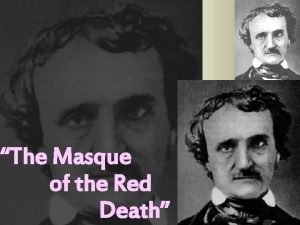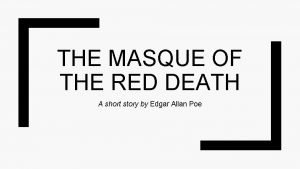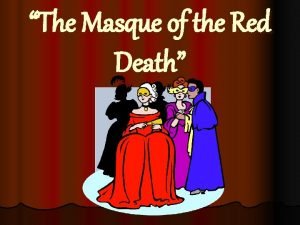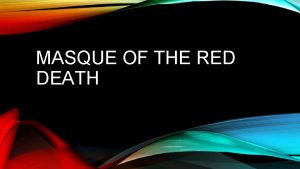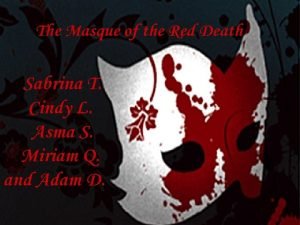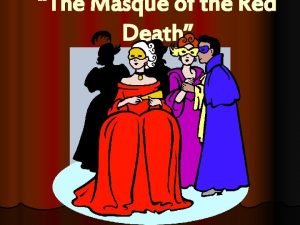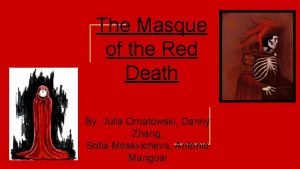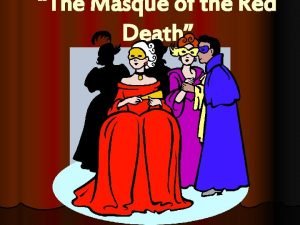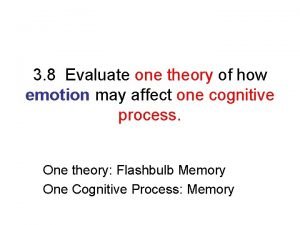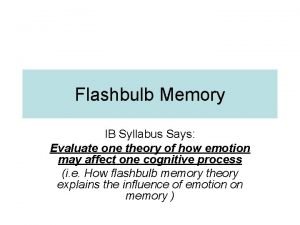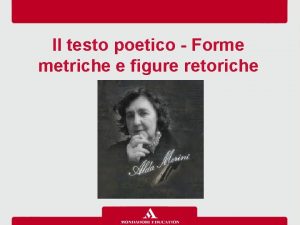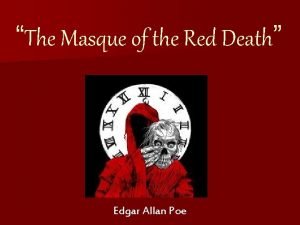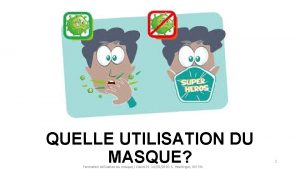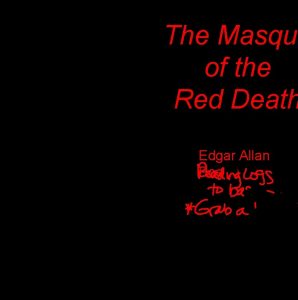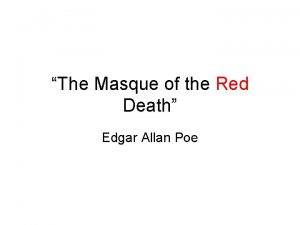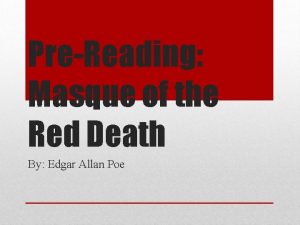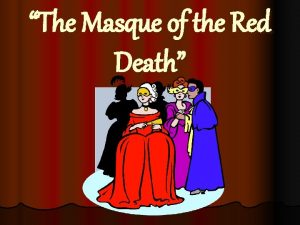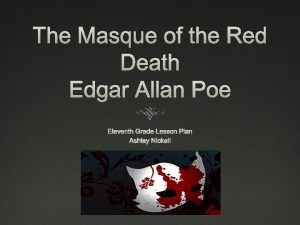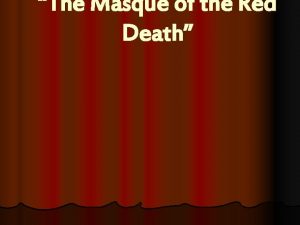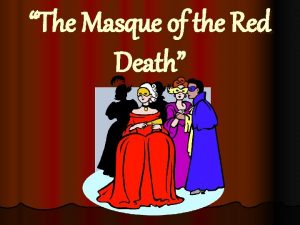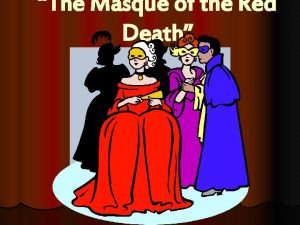The Masque of the Red Death Rachel Kulik





















- Slides: 21

The Masque of the Red Death Rachel Kulik and Olga Avram

Major Events a. The Red Death, a rapid, painful, and unsightly disease, is ravaging a country’s population. When infected the individual experiences bleeding and seizures: “there were sharp pains, and sudden dizziness, and then profuse bleeding at the pore, with dissolution” (lines 4 -5).

Major Events (cont’d) b. Prince Prospero, trying to avoid the disease, locks himself and some guests in his castle and hosts an ongoing masquerade ball. The ball is located in 7 different and out-of-the-ordinary rooms. The rooms are at odd angles to each other and are different colors. The first room is blue, the second one purple, the third one green, the fourth one orange, the fifth white, the sixth violet, and the last is black. In all rooms but the black room the people are celebrating and having fun.

Major Events (cont’d) c. The Red Death shows up at midnight unwanted and it terrifies everyone within the castle, especially Prince Prospero. He charges the unknown guest but is killed. The guests had believed that they were safe and isolated from the plague, but everyone is inundated with pain and death once they unmask the figure.

Main Characters Prince Prospero ❖Prince Prospero is a reckless ruler. While the peasants are dying of the Red Death, he locks himself and some party guests in his castle to prevent disease from reaching them, instead of facing the issues of his country.

Main Characters (cont’d) ❖He is a very wild character who is described as having a “love of the bizarre” and of entertainment, as evidenced by his grand masquerade ball and his grotesque seven rooms of different colors (page 4).

Main Characters (cont’d) ❖The prince is outraged by the appearance of the unknown guest, and out of “the shame of his own momentary cowardice” chases the guest with a dagger (page 9). The prince is clearly egotistical, and his lack of protection of his people and his neglect of recognition of the Red Death make him a profligate ruler.

Other Main Characters The Red Death b. The unknown guest who is rejected by the guests of the masquerade ball turns out to be “untenanted by any tangible form” when he is unmasked (page 10). The guest is tall, gaunt, and looks like those who suffer from the Red Death, the disease which he embodies. He appears at the party like a Grim Reaper character, because he comes unexpectedly and claims the lives of many without their consent. Like death, he has no face, but his power cannot be matched by a mortal.

Other Main Characters (cont’d) The Prince’s Guests c. The guests who stay at the Prince’s castle share in common with Prospero the belief that they can avoid the Red Death. Still, they are stopped in their tracks by the chiming of the ebony clock, and once they unmask the unknown guest in desperation, they are left vulnerable to death.

Themes Materialism Doesn’t Mean Safety: After describing the castle’s bountiful provisions, the narrator states “security [was] within” (page 3). Prospero and his guests believe that there is security in their isolation and in their high walls and grand parties, or their “appliances of pleasure” (page 3). No amount of wealth or pompousness can prevent the ultimate entrance of the Red Death into the castle. These wealthy folks cannot guarantee their immunity to the sickness.

Themes (cont’d) Time as the Sole Authority: The importance of the ebony clock and the narrator’s description of the number of seconds that pass between each of its chimes help convey the idea that every second is important. Every hour that passes during the party is full of life. The powers of the clock are great; it leads to “disconcert and tremulousness and meditation” every time it sounds, abrupting the festive partying that was taking place before (page 6). All the guests inside the castle must obey the passing of time. Like death, it is unavoidable and does not care about its victims. When the clock strikes in the story, “dreams are stiff-frozen as they stand” (page 6). Time can easily and swiftly take away what people have spent ages creating. Death, Too, Is Inescapable By the story’s end, it is clear that the guests’ methods for avoiding the Red Death were futile. Death, like the darkness of the black apartment where the Red Death was unmasked, is omnipresent. It affects all- whether Prince or peasant locked out of the castle. No grandiose precautions taken can save one from death.

Symbols: Seven Rooms ❖ The narrator describes the seven rooms and the arrangement of each of their colors from east to west. ❖ This is significant because the rooms (each of a different color) follow a path of birth and death because the sun rises in the east and sets in the west. ❖ Noticeably missing is a red-colored room, possibly because of the color’s association instead with the Red Death, which the guests are desperate to avoid.

Symbols: Seven Colors ❖ There are seven colors in the rainbow, but the colors of the rooms are not ROYGBIV. Instead, the arrangement of the colors from east to west symbolizes the course of life, or the beginning of life coming to an end. ❖ Blue is calm and pure and represents birth, purple is a mix of blue and red and represents youth, green is the color of nature blooming and represents adolescence, orange is a mix of yellow and red and represents adulthood, white is the color hair becomes when one ages and it represents old age, violet is a mix of blue and purple and represents looming death, and black represents death. The black room is the one “few of the company [were] bold enough to set foot within” (page 5). This room contains blood red as well, another symbol for death, which explains why the people feared to enter it and party in there. Prospero chases the Red Death through these seven rooms, and dies upon reaching the black room. ❖ When the Red Death makes his way from the Blue room to the Black room it can be interpreted that it makes its way through life of all kinds of stages, from the beginning to the end. It wouldn’t matter where you are in life, death can claim you whenever it pleases.

SEVEN ROOMS DECORATED DIFFERENTLY FOR EACH STAGE OF LIFE

Symbols: The Ebony Clock ❖ The ebony clock is an important symbol that relates to theme of time’s authority. ❖ In the story, the clock chimes every hour, and when it would ring “the giddiest grew pale” (page 5). ❖ The clock is located in the black room, which is significant because of the relationship between time and death. Both are unavoidable and have the power to stop everything in their way. ❖ The clock’s chimes put a pause in the musicians’ cheerful playing and the laughter of the party. It is a symbol of time passing by and a reminder to the people within the castle that death is approaching and time is running out.

Setting ❖ A fictional country where the Red Death has devastated half of the population. ❖ The lavish castle of Prince Prospero- “an extensive and magnificent structure” that contains many elements that, like the Prince, are bizarre (page 1). A high wall keeps guests of the Prince’s masquerade ball inside and all peasants outside. ❖ A series of seven rooms in the castle that stretch from east to west and are each a different color, and all but the black one are “densely crowded” (page 7). The large ebony clock located in the black room; its chimes silence the party’s musicians.

Mood ❖ At first in the palace there is celebration everywhere but the black room. That room is avoided by the guests. Outside the palace there is a very dark mood because of the plague. At the end in the palace the mood is also very dark because the Red Death reached them inside the palace. ❖ As is common in Dark Romanticism, Poe creates an atmosphere of fear in this story. This is conveyed by the grim imagery the author uses in describing the Red Death’s marks (“the redness and the horror of blood”), the “ghastly” black room with its sinister ebony clock, and the unknown guest who horrifies the guests and has the appearance of a corpse (pages 3, 5).

Conflict and Resolution ❖ The conflict is Prospero’s attempt to escape death or keep it out of his castle. He fears death. ❖ The resolution is when the Red Death, or death itself, is victorious. It has quickly claimed the lives of all of Prospero’s guests in their tracks, and “Darkness and Decay and the Red Death held illimitable dominion over all” (page 10). Nobody could triumph over this inescapable force.

Point of View of the Story The story is written in the point of view of third person (omniscient). In other words, the narrator describes the setting and the events from a detached standpoint. He is like an observer who knows the facts of the Red Death, Prospero’s party, and the reactions of Prospero (who feels ashamed with his inability to stop the unknown guest) and the guests (who are disturbed by the guest).

Elements of Gothic and Dark Romanticism The story, like other Dark Romantic works, focuses on the bizarre. Poe uses imagery of a grotesque, bloody, fatal disease (“the redness and the horror of blood”, page 3), a magnificent castle (“castellated abbey”, page 3), an eerie arrangement of rooms (“the dark hangings through the blood-tinted panes”, page 5), an abnormal response to the chiming of an ebony clock (“dull, heavy, monotonous clang”, page 5), and a mysterious, cloaked figure who makes the other guests shudder when they spot him (“countenance of a stiffened corpse”, page 8). These gloomy descriptions are filled with emotion, another common element of Dark Romanticism. This conveys a ceaseless mood of fear that makes readers feel uneasy throughout the story.

Analysis/Summary from the POV of a peasant locked out of the castle It feels like it’s been ages since I first witnessed the Red Death’s effect on my village. Our neighbors have fallen victim to this horrid disease. Through our windows we have seen them cry out and drop to the floor in pain and have trouble getting up, but the worst part is the way they bleed from their pores. There is panic in the village as everyone is afraid of being infected; we’re worried the disease is highly contagious. I’ve forbidden my own children from leaving my sight. Yesterday, however, my youngest one, Cedric, went missing. I searched all over town for him and saw bloody corpses everywhere, and finally found him outside Prince Prospero’s gates, banging his fists on the iron door. I wondered why he was throwing a tantrum, but then it occurred to me. The palace was well-it and joyful music was coming from the windows. The smell of pastries wafted through the air, and I could see Prospero dancing among masked guests in bizarre gowns. The music stopped when the clock chimed, and all of a sudden I heard the tortured cries of Prospero and later his guests. The joy of the party had turned into the same agony that was so familiar in the village.
 What does the ebony clock symbolize
What does the ebony clock symbolize Summarize the masque of the red death
Summarize the masque of the red death The masque of the red death symbols
The masque of the red death symbols The masque of the red death rooms
The masque of the red death rooms Conflict in the masque of the red death
Conflict in the masque of the red death Metaphors in the masque of the red death
Metaphors in the masque of the red death Conflicts in the masque of the red death
Conflicts in the masque of the red death Why does the visitor frighten the guests
Why does the visitor frighten the guests Brown and kulik (1977)
Brown and kulik (1977) Jacob kulik
Jacob kulik Brown and kulik 1977
Brown and kulik 1977 Flashbulb memory
Flashbulb memory Forensics pathology definition
Forensics pathology definition Figure metriche poesia
Figure metriche poesia Artistry pore cleansing masque
Artistry pore cleansing masque Cfo masqué
Cfo masqué Masque de bahtinov à imprimer
Masque de bahtinov à imprimer Scarlet ibis setting
Scarlet ibis setting The red death disease
The red death disease Simile in stereo hearts
Simile in stereo hearts Yellow je
Yellow je Colors red orange yellow green blue purple pink
Colors red orange yellow green blue purple pink
